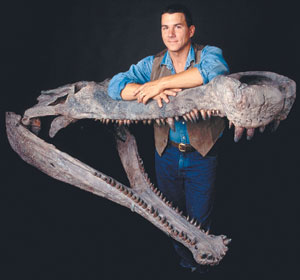What's new in exploration
Remarkable fossil finds; gravity mappingA team led by University of Chicago paleontologist Paul Sereno, a National Geographic Society Explorer-in-Residence, has made a remarkable fossil discovery: the skull of Sarcosuchus imperator, nicknamed SuperCroc. The behemoth’s skull was found in the Cretaceous El Rhaz formation in the Tenere Desert of Niger, a part of the Sahara. The giant African crocodile lived 110 million years ago. The monster’s skull was nearly 6 ft long, it measured up to 40-ft long and its torso was 5 ft in diameter. Weighing almost 18,000 pounds, it could easily chomp down small dinosaurs. SuperCroc was covered head to tail with bony-plate "scales," each one showing growth rings. Using these rings, the Sereno team estimated they grew throughout a 50 – 60 year lifespan. Sarcosuchus was known to exist since French geologists first unearthed fragmentary bone remains in 1964; but without a skull, its size was unknown. "There is a well-documented relationship between head and body size in crocodilians," Sereno says. The team’s discoveries included six different species of crocodiles and over 20 tons of fossils. The National Geographic Channel will present Sarcosuchus on Sunday, Dec. 9. Sereno also will write about his discovery; the article will be published in the December issue of National Geographic.
That’s a big bug. Although the ad says diamonds are forever, in reality, it’s the cockroach that gets the perseverance award. Scientists at Ohio State University discovered a 3.5-in.-long, 300 million-year-old fossil cockroach in a northeastern Ohio coal mine. Cary Easterday, a geology graduate student at Ohio State, presented the fossil discovery at the Geological Society of America meeting in Boston this November. It is the largest, most complete fossil of its kind. Easterday and Loren Babcock, his advisor / professor at Ohio State, hope to discover more fossils in the coal mine. This could lead to understanding the paleoenvironment of Carboniferous tropical swamps that covered the U.S. Midwest about 300 million years ago. The unique conditions of these swamps preserved the cockroach’s antennae, legs, wings, as well as the wing surface in fine detail. Amazing GRACE. Sir Isaac Newton, eat your heart out! A pair of satellites will soon begin mapping tiny variations in Earth’s gravity, allowing scientists to track the motions of mass around and beneath the globe for the first time. NASA’s upcoming Gravity Recovery and Climate Experiment, or GRACE, will use a pair of satellites to map tiny variations in Earth’s gravitational field. Earth and its gravitational field are rather lumpy. The system operates by monitoring the distance between the two satellites to within one micron. These tiny changes in gravity, from place to place and over time, can reveal a great deal about Earth’s oceans and its hidden interior. GRACE will improve the accuracy of tectonic mantle features at least a hundredfold. New field discoveries. A significant gas and oil discovery was made by Shell Egypt (operator) and Apache Corp. on Northeast Abu Gharadig concession in Egypt. The JG-1X exploration well tested 4,190 bopd and 5 MMcfd of gas. The Western Desert discovery was tested on a 3/4-in. choke with 1,170-psi FTP. It was perforated between 10,497 ft and 10,517 ft in the Khatatba Sandstone. The Jurassic-age producing depth is new to this part of the Abu Gharadig basin. Pipelines less than two miles away should allow for early production. Shell Egypt has a 52% contractor interest in the concession, Apache has the remaining interest. Marathon Oil discovered oil on its Ozona Deep prospect in the Gulf of Mexico. Located in 3,280-ft of water in Garden Banks Block 515, the well was drilled to 26,352-ft MD. Based on logs and fluid samples, about 345 ft of net pay was encountered in two primary intervals. The well will be suspended without testing. Marathon is operator and has a 68% working interest, with Pioneer Natural Resources holding 32%. The company said further work will be needed to determine 2002 appraisal plans and possible development options. Marathon plans seven more wells – four in the Gulf of Mexico, two offshore Nova Scotia and one offshore Angola. Kerr-McGee discovered a deepwater gas / condensate field in the Gulf of Mexico at its Red Hawk prospect, Garden Banks Block 877. Located in more than 5,300 ft of water, the 23,500-ft exploration well found more than 135 ft of gas and condensate pay in two zones. A sidetrack was drilled updip to the discovery and encountered about 175 ft of gas and condensate pay. Red Hawk, located south of Baldpate and Conger developments, is in an area where Kerr-McGee currently holds 21 blocks and follows a series of deepwater discoveries by the company. Estimated reserves range 300 – 500 Bcfg. The company plans to drill an appraisal south of the discovery. Kerr-McGee operates Red Hawk with 50% interest, with Ocean Energy holding 50% interest. The partners expect to drill another deepwater GOM prospect, South Titan in Walker Ridge Block 313, before year-end.
|




